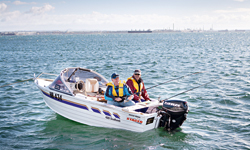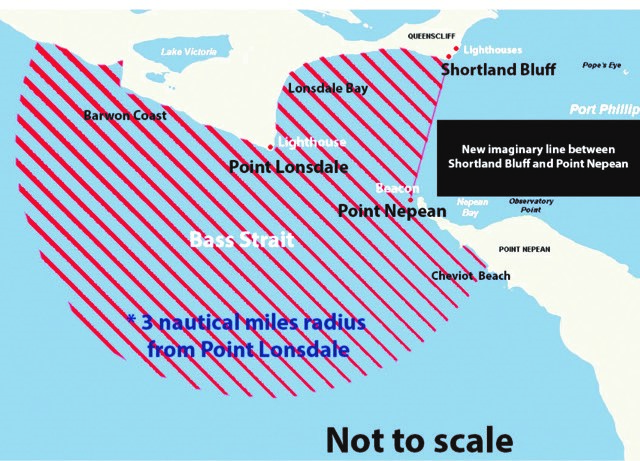Staying safe when fishing
Fishing is a fun and healthy activity for everyone, and we want to keep it that way!
Before heading out to wet a line, please take the time to read through the safety tips below.
Wind warnings and forecasts
Always check the latest forecast before you go on the water. Visit the Bureau of Meteorology's marine weather forecast.
Fishing from banks, shore, piers and platforms
We all are Hooked on Safety
For a SAFE fishing adventure (of any type):
- CHECK water and weather conditions before you go
- NEVER fish alone: always fish with a friend.
- ALWAYS tell friends or family of your plans – where you are going, when you will be returning, who is going with you and what your plan B is (if conditions are not suitable at your planned destination).
- WEAR a lifejacket, carry safety gear (including a phone) and a first-aid kit.
- WEAR appropriate clothing and footwear with non-slip soles.
- WATCH the water at all times as conditions can change dramatically in a short time.
Have a great day fishing and tight lines.
Rock fishing
Safety tips when rock fishing:
- Check water and weather conditions before you go.
- Always tell friends or family of your plans – where you are going and when you will be returning.
- Never fish alone.
- Wear appropriate footwear with non-slip soles.
- Wear a personal flotation device and carry safety gear and a first-aid kit.
- Wear light clothing that will allow you to swim easily if you are washed in.
- Don't wear waders when rock or ledge fishing.
- Seek out local advice on your intended fishing spot – tidal behaviour and accessibility.
- Observe first and fish later. Take time to judge your intended spot before fishing to get an idea of tidal and sea conditions plus access and escape routes.
- Always obey danger signs and never trust access and escape aids such as ropes and makeshift steps.
- Have an escape plan. If the swell threatens your position, leave immediately.
- Never turn your back on the sea.
- Watch the sea at all times as conditions can change dramatically in a short time.
The Victorian Government’s Play it Safe by the Water campaign is actively working towards increasing community awareness of water safety. For further information, click here.
Safe diving
Diving for abalone is relatively safe, but there is a risk of drowning. To stay safe, you must:
- Dive when sea conditions are good
- Always dive and stay with a friend so there is someone there to help if you get into trouble.
- If conditions are not right, find a better spot or dive on another day
Speargun safety
Spearfishing is lots of fun and a great way to catch a feed of fish. However, speargun safety is very important to ensure you do not hurt yourself or others. If you are going spearfishing, there are a couple rules you should always follow:
- Never load a speargun out of the water and never shoot a speargun out of the water.
- Always unload your speargun before taking it out of the water and never carry a loaded speargun in a populous place (e.g. when crossing a beach or rocks to get to the water).
- Never point a loaded spear gun at another person and always identify your target and know what is behind your target before you shoot.
- Always leave the safety lock on until you’re ready to fire and always keep you finger away from the trigger until you are ready to shoot.
- Ensure there are no tangles in your float line before firing.
- Have a dive plan and let someone know what it is and always dive with a buddy.
- Never tether your fish to your body and always carry a dive knife.
Spearguns are prescribed as controlled weapons under the Control of Weapons Act. It is an offence under section 6(2) of that Act to carry a controlled weapon unless it is carried in a safe and secure manner consistent with the lawful excuse for which it is possessed or is carried or is to be used. This is an "associated offence" under the Fisheries Act, meaning it can be enforced by Fisheries Officers.
Safe boating
 We recommend that all boat-based anglers read the Victorian Recreational Boating Safety Handbook before they hit the water.
We recommend that all boat-based anglers read the Victorian Recreational Boating Safety Handbook before they hit the water.
The Victorian Recreational Boating Safety Handbook can be downloaded .
Safety tips when boating:
- Check the weather forecasts. Consider postponing your trip if the weather is unfavourable and avoid areas exposed to high wind and waves.
- Ensure your boat is properly maintained, the battery is fully charged and you have enough fuel on board.
- Seek up-to-date local knowledge and obtain a copy of the appropriate chart or map for the area you will be navigating.
- Always let someone know where you are going and when you plan to return.
- Ensure you have the correct safety equipment aboard your boat and you know how to wear it correctly.
- Don’t drink alcohol while boating.
- Observe speeds and distances.
- Operate at a safe speed and always maintain a good lookout.
- Always wear a lifejacket. It is mandatory to wear a lifejacket in Port Phillip Heads. Port Phillip Heads means all the waters between an imaginary line drawn between Shortland Bluff and Point Nepean, and the seaward limits of an imaginary line consisting of the arc of a circle with a radius of 3 nautical miles centred on Point Lonsdale. The area shaded in red on the map on page 92 marks where it is mandatory to wear a lifejacket.
Click here for more information on boating safety or call 1800 223 022 for a copy of the Victorian Recreational Boating Safety Handbook.
Port Phillip Heads - Know your boundaries
Port Phillip Heads is a major shipping channel, dive location and popular fishing destination.
It’s also home to Marine National Parks and Sanctuaries where no fishing can take place.
The best way to avoid Marine National Parks and Sanctuaries is to use the ‘Can I Fish Here’ function on our app.
Download our Vic Fishing app via the App Store or Google Play.

